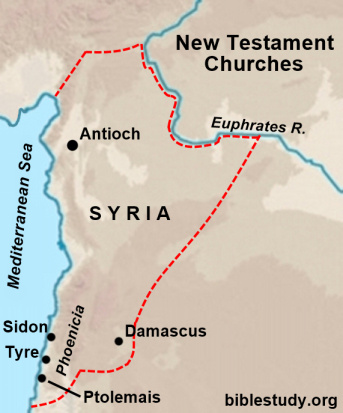In the King James Bible, Damascus is directly named at least sixty times. The city's first Biblical mention is in the book of Genesis, where it is connected with Abraham's military victory over a confederation of kings led by Chedorlaomer (Genesis 14:15).
Some of the earliest New Testament successes in spreading the gospel were found in Damascus. A man named Saul, who would be renamed Paul, traveled to the city in 33 A.D. to haul off to jail all those in the synagogues who believed in Jesus (Acts 9:2). On his way God struck him blind and began to stir him to repentance.
The Lord, after Saul had fasted for three days, contacted a disciple named Ananias who lived in the city. He commissioned him not only to visit and heal Saul of his blindness but also to baptize him (Acts 9:10 - 18). After Saul received God's spirit, it was only natural that he would make the city his first evangelistic effort. His teachings and the ability to prove that Jesus was the Messiah was so powerful, however, that Jews in Damascus sought to murder him (Acts 9:20 - 25)!

Tyre
Ancient Tyre, like the Palestine city of Sidon situated twenty miles from it, is located in modern Lebanon and is mentioned several times in Scripture (2Samuel 5:11, Isaiah 23, Ezekiel 27, etc.). It, along with Sidon and several other Mediterranean coastal cities, were a part of ancient Phoenicia.
One of Tyre's kings, named Hiram, was an ally and trading partner of Israelite kings David and Solomon. He was instrumental in providing building materials for David's royal palace David (2Samuel 5:11) and generously offered materials and skilled craftsmen to build Jerusalem's Temple (2Chronicles 2:3 - 16).
Jesus visited the area near Tyre during his ministry (Matthew 15:21, Mark 7:24). Those who lived in this Palestine coastal city were willing to travel to the shores of Galilee to hear Christ preach (Mark 3:8, Luke 6:17).
Sidon
Sidon, located in modern-day Lebanon, is considered one of the oldest, continuously inhabited cities of the Middle East. According to Barnes' Notes on the New Testament, the city was famous for its great trade and navigation. Those who lived in it were remarkable merchants and known for their luxury. In fact, even after coming under the control of the Roman Empire, Sidon still minted its own silver coins.
Sidon is mentioned at least fourteen times in Scripture, most notably as an area Jesus visited during his ministry and a place from which they came to hear him speak (Matthew 15:21, Mark 3:8, 7:24, 31, Luke 6:17). Paul, as a Roman prisoner bound from Rome, is taken to Sidon where he is allowed to visit fellow believers in the city (Acts 27:3).
Ptolemais
Ptolemais was a Palestine coastal city originally referred to as Accho in the King James Old Testament (Judges 1:31). It is mentioned only in the Book of Acts. Toward the end of his third missionary journey Paul sails to the city and visits church members for one day before leaving for Jerusalem.
Then we completed our voyage from Tyre and arrived at Ptolemais. And after greeting the brethren, we remained one day with them (Acts 21:7, HBFV).